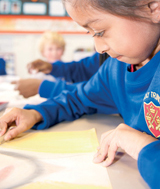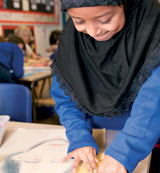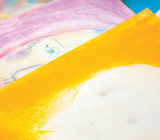Robert Watts' shares his blueprint for making the most of children's artistic talents...
For the past few years, part of my role as a lecturer in primary art education has included teaching a module designed for aspiring subject leaders of art and design. With their three years of lectures completed, it’s the last module the students take before they set off into the big wide world, and I like to give them the opportunity to summarise what they’ve learned from their experiences of teaching art during their school placements.
Recently, one group came up with a particularly interesting list of suggestions that offered some sound advice for teachers. Try something new, one student suggested. Let children inspire your planning, recommended another. Other voices quickly chimed in with further tips: always offer children choices; give them time to explore and experiment; encourage children to express themselves. The list went on. As I diligently recorded their suggestions on the whiteboard I gradually realised that the students’ suggestions came together to form, from start to finish, a blueprint for the perfect art lesson.
I was impressed with the students’ ability to succinctly summarise their notions of good practice in art education and with how well they identified the key features of a successful art lesson. And it’s just as well that newlyqualified teachers are arriving in schools well-equipped to teach art: given that its place in the primary curriculum, along with several other foundation subjects, is increasingly precarious, it may be that the amount of time devoted to art on teacher education courses will soon be drastically reduced.
So, if you value the future of art education in your school, whether you are a subject leader for art and design or simply someone determined to improve their art teaching, take the time to cut out these pages and paste them up in your art corner: your future colleagues, and the children they teach, might be grateful.
 Now this might seem like a strange suggestion to begin with, but taking the decision to experiment with an art activity that you’ve never taught before can often result in the most interesting and exciting lessons. It may take a little extra time to research a new idea or two but, once you’ve located an inspirational activity, you’ll find you feel extra enthusiasm for the project. And if children see that you are on your own voyage of discovery, they’ll be more motivated to learn alongside you.
Now this might seem like a strange suggestion to begin with, but taking the decision to experiment with an art activity that you’ve never taught before can often result in the most interesting and exciting lessons. It may take a little extra time to research a new idea or two but, once you’ve located an inspirational activity, you’ll find you feel extra enthusiasm for the project. And if children see that you are on your own voyage of discovery, they’ll be more motivated to learn alongside you.
We’ve all experienced the process of rummaging through resources in search of inspiration for an art lesson, but quite often the answer is right before our eyes in our own classrooms. Take a closer look at the ideas that your children are already exploring in their artwork, and use these as starting points for new activities. You don’t need to start from scratch every week – sometimes children need to re-visit activities in order to fully engage with their learning. For centuries artists have extended and refined their ideas and experiments, and it makes sense to provide children with time and space to do the same.
 Ofsted subject reports on art and design have consistently identified issues regarding the narrow breadth of the art curriculum in many primary schools. As a trainee teacher you will have had opportunities to experiment with a number of practical processes, but the chances are that you will feel more confident with some than with others. While most teachers are relatively secure with a pencil or paintbrush in their hand, demonstrating techniques relating to printmaking, sculpture or textiles might prove to be a little more demanding. This is where subject leaders can play a key role in ensuring that the breadth of the art curriculum is represented inyour school, by analysing colleagues’ needs and providing targeted practical support.
Ofsted subject reports on art and design have consistently identified issues regarding the narrow breadth of the art curriculum in many primary schools. As a trainee teacher you will have had opportunities to experiment with a number of practical processes, but the chances are that you will feel more confident with some than with others. While most teachers are relatively secure with a pencil or paintbrush in their hand, demonstrating techniques relating to printmaking, sculpture or textiles might prove to be a little more demanding. This is where subject leaders can play a key role in ensuring that the breadth of the art curriculum is represented inyour school, by analysing colleagues’ needs and providing targeted practical support.
Imagine you are in a gallery. How would you feel if every artwork on every wall were exactly the same size? A little disappointed? A little bit bored? The perfect art lesson would be one that produced diverse outcomes, not identical ones, so always offer children choices. Encourage them to make decisions about the scale on which they work, the materials they use, even whether they want to work alone or as part of a group. Remember - if an artwork needs to be named in order to be recognised by its owner, then it’s probably because it looks identical to every other artwork in the lesson.
 Having had opportunities to make some decisions about the way their work will look, children will be much better placed to create artworks with a little individuality and originality. Many of the artworks that make an impression on children are those where artists express a personal approach that makes their work distinct from that of other people. Encourage children to recognise that copying from examples can be limiting and restrictive and that their own ideas have unique value.
Having had opportunities to make some decisions about the way their work will look, children will be much better placed to create artworks with a little individuality and originality. Many of the artworks that make an impression on children are those where artists express a personal approach that makes their work distinct from that of other people. Encourage children to recognise that copying from examples can be limiting and restrictive and that their own ideas have unique value.
Every classroom in the country contains an artwork that was started with the best intentions but has been abandoned before its maker’s ambitions were realised. Most art lessons aren’t long enough for children to genuinely explore their ideas and experiment with new techniques – the inevitable pressures of the timetable prompt us to curtail their creative efforts even when we know they need more time. Try to give children time to explore and experiment with ideas and techniques, without the pressure of having to create a specific, ‘finished’ piece. Even if you urgently need artwork for your displays, consider exhibiting children’s experiments alongside their finished pieces.
 Allocate time at the end of each art lesson for feedback. Select two or three pieces that you find interesting, settle the class for a brief plenary session and invite their opinions on the work. Find something to praise in every piece, and try to identify possible ways in which the work could be developed in a future lesson. This can be the most valuable part of an art lesson: children’s individual perspectives on artworks may be more interesting and original than our own, and the process of listening to each other’s opinions can be an exciting and rewarding experience.
Allocate time at the end of each art lesson for feedback. Select two or three pieces that you find interesting, settle the class for a brief plenary session and invite their opinions on the work. Find something to praise in every piece, and try to identify possible ways in which the work could be developed in a future lesson. This can be the most valuable part of an art lesson: children’s individual perspectives on artworks may be more interesting and original than our own, and the process of listening to each other’s opinions can be an exciting and rewarding experience.
Imagine again that you are in a gallery - only this time you’ve brought your friend along. And although the two of you get on fine, you find that you don’t agree about all the artworks you see. We each have our own preferences, our own opinions about one artwork compared to another, even about one colour compared to another (if you need evidence of this, take a look at the couples arguing by the little paint charts in the DIY store!). Responding to art is a subjective experience, so try to remind children that, unlike those spelling tests they completed this morning, in art there is no right or wrong – just your own way of doing something.
Robert Watts is a senior lecturer in art and design education at University of Roehampton, London, and the co-author of Teaching Art and Design 3-11, published by Continuum Books
Help Pupils Tell Fact From Fiction In The Digital World
Ace-Computing
How children react to a moral dilemma may be down to your teaching
Ace-Classroom-Support
If your marking doesn’t affect pupil progress - stop it!
Ace-Classroom-Support
